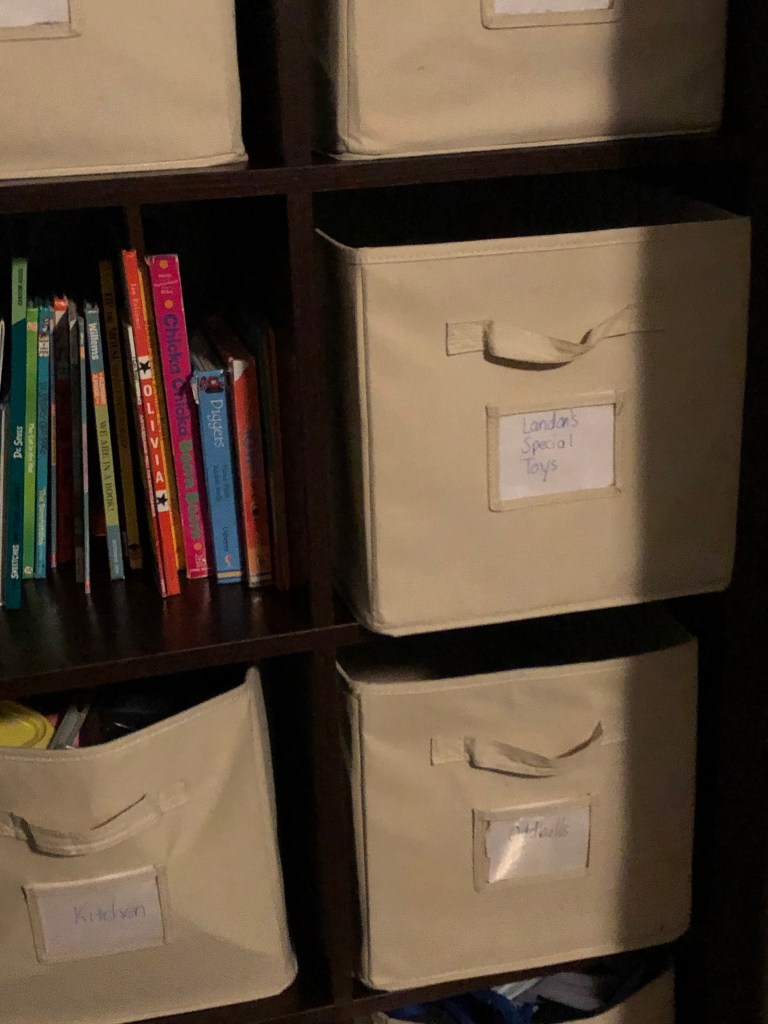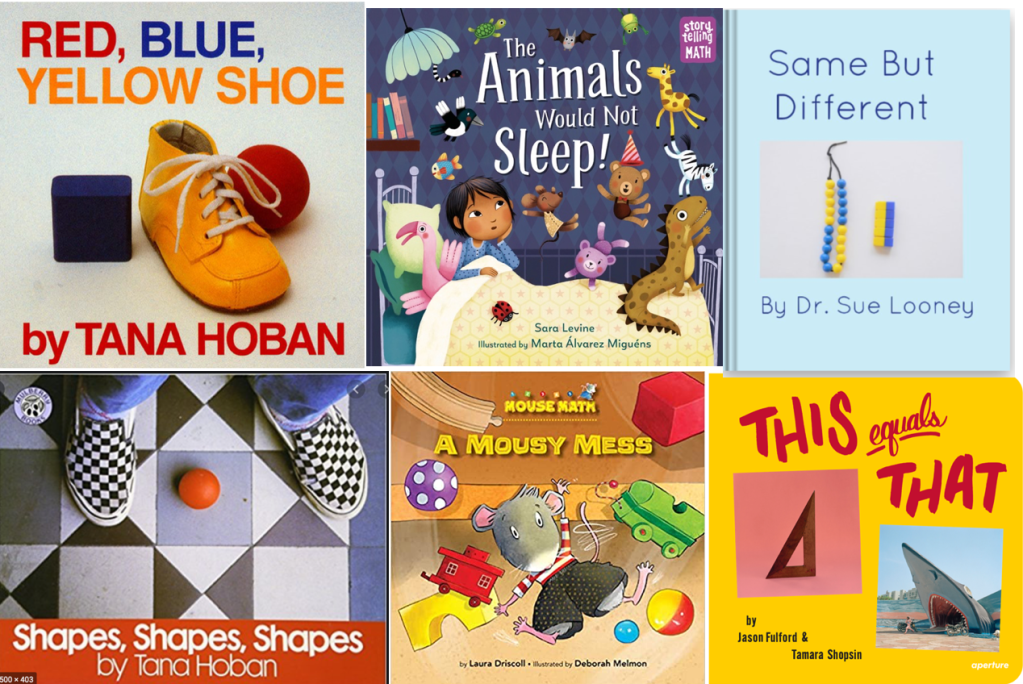The explorations below are for parents of child ages 2-6 (although teachers may find them useful and may adapt them for their purposes as well). These explorations are organized according to a list of big Ideas from The Big Ideas of Early Mathematics: What Teachers of Young Children Need to Know (referred to as Big Ideas below) by Erikson Institute’s Early Math Collaborative. You can find out more about this book here on my blog www.mathbookmagic.com. In this book, 26 big ideas are organized under 9 topics. This post is about the first topic, Sets, and its three related big ideas.
SETS: Using Attributes To Sort Collections
Sets are fundamental mathematical objects. For example, they are basic to our number system and counting. For example, before you can count something, you have to decide what to count and that involves identifying sets. Take a look at the image below and answer the question: How many?

If you answered, 20, you probably counted all the beads. There are 20 beads. How else could you answer the question, How many? Here are a few possible answers: There are 10 animal beads. There are 5 red beads. There are 2 red animal beads. All of these counts involve forming sets before counting: a set of animal beads, a set of red beads, and the subset of red animal beads. Note: Making sets may involve physically separating out the sets or mentally identifying sets.
Here are three big ideas Erikson Institute’s Early Math Collaborative identifies for Topic 1: Sets:
Big Idea 1a: Attributes can be used to sort collections into sets. [Examples of attributes: Color, size, shape, fill patterns]
Big Idea 1b: The same collection can be sorted in different ways.
Big Idea 1c: Sets can be compared and ordered.
*The Erikson book does not include these letter labels (a, b, c). I do this for clarity. They are not meant to denote any sort of learning progression.
These three big ideas provide helpful anchors for exploring sets. The games, questions, books, resources, and activities are possible ways to engage with big ideas 1a, 1b, 1c. Be sure to listen closely for the magical ideas of your brilliant children.

SOCK SORT
On laundry day (which is basically everyday at my house). Have your child help sort socks. Discussion of the different attributes: colors, patterns, sizes, owners will naturally arise. Finding exact matches (either using socks or with memory type matching games) is a great way to start talking about sorting. You might ask: Where is the match? How are these the same? How are these different?

BUTTON SORT
We read the classic story The Lost Button (from the Frog and Toad series) by author Arnold Lobel and sorted some old buttons. Here is Landon’s selection for which buttons matched the one that Toad lost from the book. From the story, Toad lost a white (these buttons look grey, but they are indeed white), four holed, big, thick, round button. Taking each attribute individually, I asked Landon to sort the buttons until he found Toads button. For example, I asked: where are all the white buttons? [He separated the buttons into two piles, white and nonwhite].

TOY SORT
My son’s toys are in bins. In the past, I’ve written different labels on the bins. There was a bin for cars and tracks, two bins for costumes, two bins for play food and dishes, one bin for instruments, one bin for puppets. Nothing ever actually stayed THAT sorted of course. But recently I asked Landon to figure out a sort he preferred. We dumped the toys in a pile, I asked him to decide how to sort his toys. He came up with one bin for costumes, one kitchen bin, one bin for cars/planes/helicopter, one bin for tools, one Landon’s special toy bin (I suggested the name after I noticed him placing select favorite toys in a pile), Oddballs (his sister suggested this label at the end, and he liked it). Toy sorts offer opportunities to see that the same collection of toys can be sorted in multiple ways.

MATH AND CRAFTS
We used pipe cleaners/ chenille stems and made bead bracelets and heart shapes (since it was around Valentine’s Day). Stringing beads on yarn or pipe cleaners offers lost of opportunities to discuss attributes as you share how you made your design. If you used a pattern, describe it. If you used only particular beads, share this with your child. Ask your child about their design. The beads we used can be found here.

GAMES
SET is a favorite game in our house. If you’ve never played it does take a bit to get clear of how it is played, but it is so worth it! We use these directions to adapt the game for Landon (Not there is a junior version of SET for those interested, we do not have this). These directions come from math educator Kent Haines’s website Games for Young Minds which has a great selection of games in addition to SET to check out. The Erikson Website has more suggestions of games centered on sets as well.

READ
Here are some books that explore sets and attributes. Click each link for more information: Animals Would Not Sleep! by Sara Levine and Marta Álvarez Miguéns. Arnold Lobel’s Frog and Toad are Friends: A Lost Button (see Button Sort above), Tana Hoban’s books are great for noticing and wondering about attributes (here a few geometry books, but check out the book section of the post for a list of her over 100 books). A Mousy Mess by Laura Discoll and Deborah Melmon. This Equals That by Jason Fulford and Tamara Shopsin. Same, but Different by Susan Looney. Also, Erikson Website for more books centered on sets.

[…] on the math of sets and some ideas on how to play around with sets at home: check out my new post at http://www.fairymathmother.com. Additionally, the Charlesbridge website offers Animals Would Not Sleep! […]
LikeLike
[…] blog http://www.mathbookmagic.com. We wrote about the first topic, Sets, and its three related big ideas here. This post continues with the second topic, Number sense, and its three related big […]
LikeLike
Ooh Set! I know my parents have that game; I’ll have to ask my mom if I can borrow it. I can see my son having a lot of fun with it.
LikeLike
Yes! It is the best:)
LikeLiked by 1 person
In the meantime: https://www.setgame.com/set/puzzle daily puzzle:)
LikeLiked by 1 person
Awesome! Thank you 🙂
LikeLike
Awesome! Thank you 🙂
LikeLike
[…] I remembered the post about sets I had read the other day on the Fairy Math Mother. (Isn’t that a wonderful name for a blog?) […]
LikeLike
[…] on the math of sets and some ideas on how to play around with sets at home: check out my new post at http://www.fairymathmother.com. Additionally, the Charlesbridge website offers Animals Would Not Sleep! […]
LikeLike
[…] Read all about it: HERE […]
LikeLike